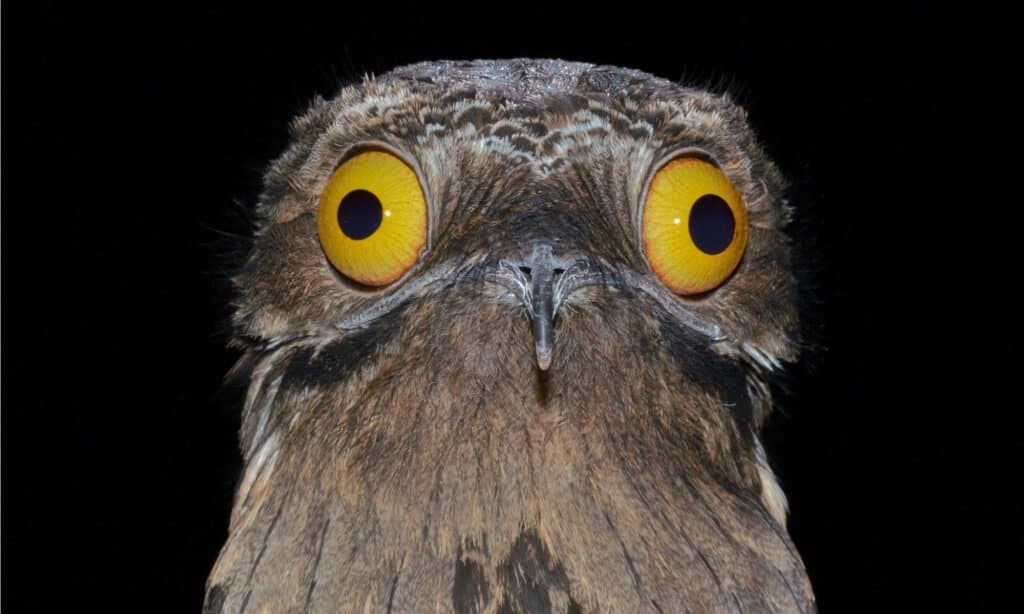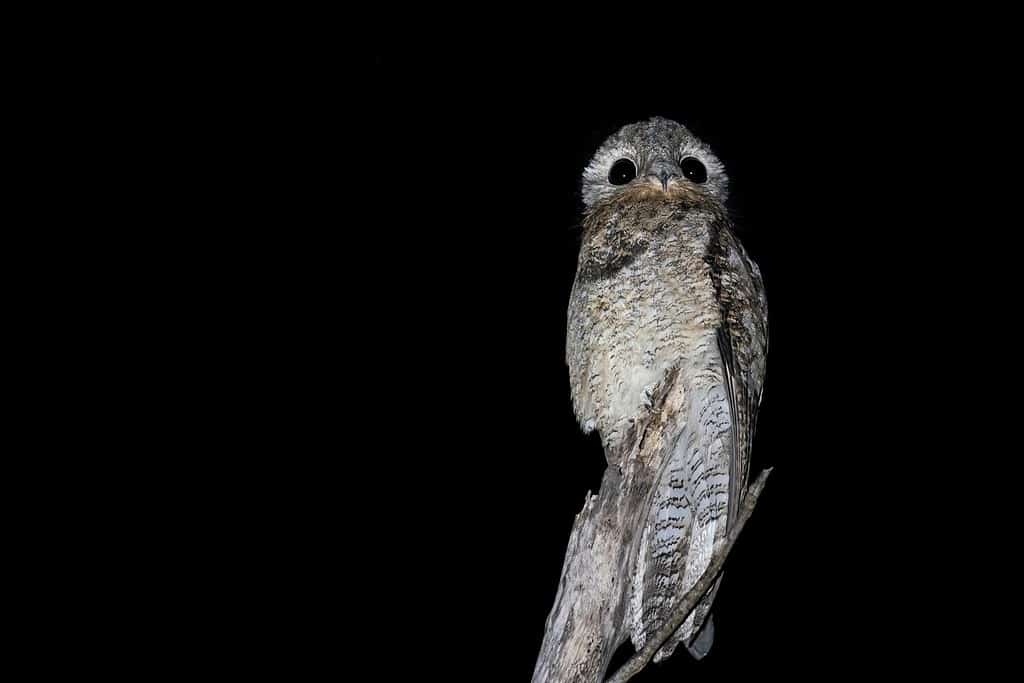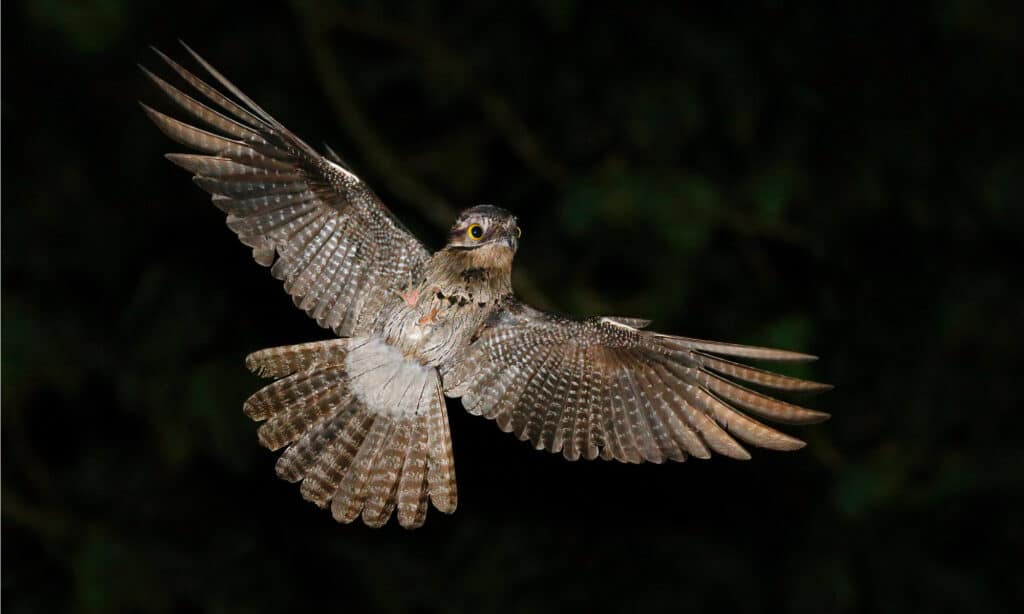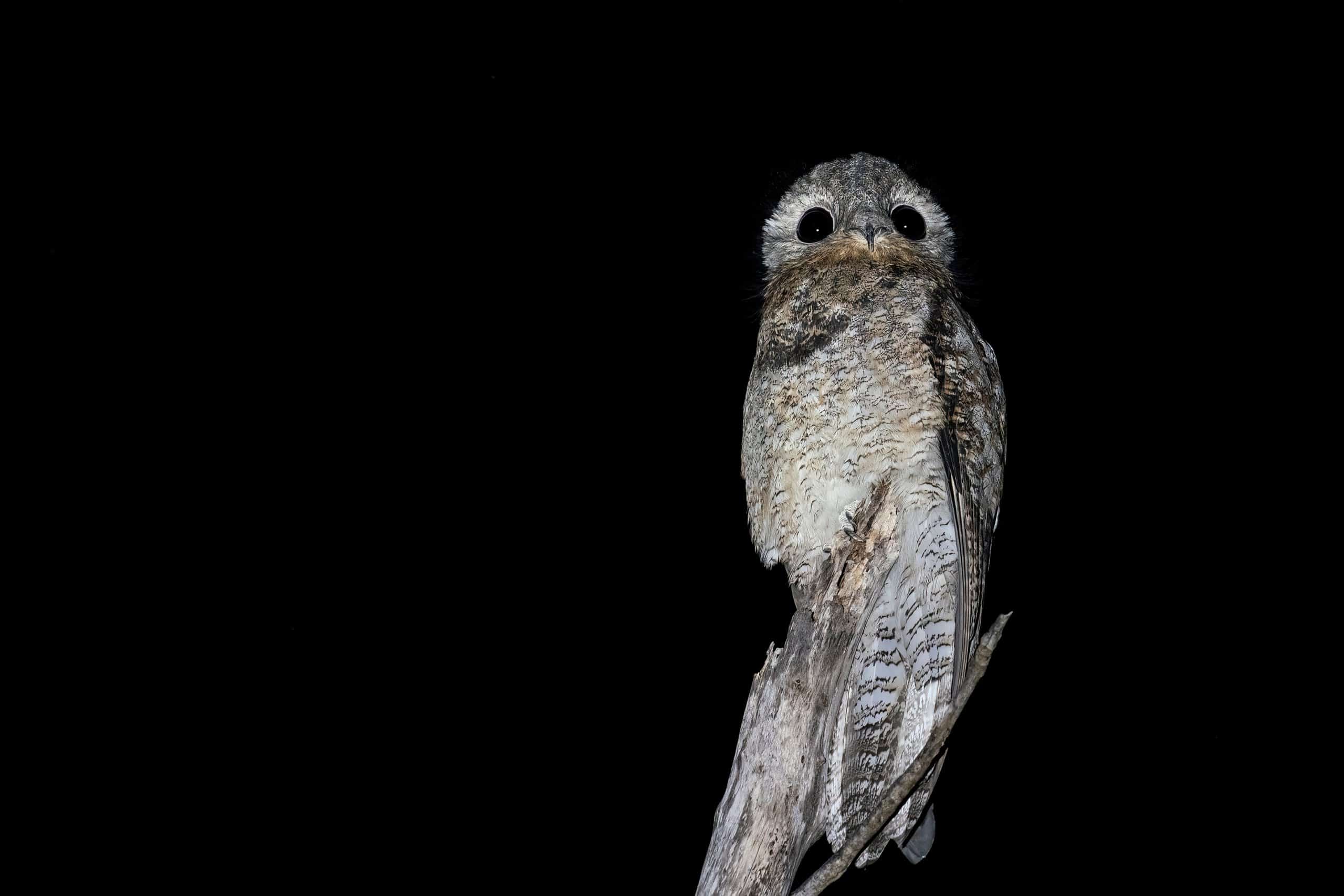If you’ve heard of the ghost bird or seen those videos of the weird, bark-like birds in the Amazon, you’ve seen potoos. The fascinating birds actually come in seven different species, all within the Nyctobiidae family, and all native the Latin America. Let’s explore two of the most intriguing birds in the world, the common potoo vs. the great potoo and see what makes each so remarkable.
What in the World is a Potoo?

The common potoo has bizarre eyes which help earn the birds the nickname of “ghost bird.”
©Fabio Maffei/Shutterstock.com
Belonging to the Nyctobiidae family, potoos are unique birds coming in seven species overall. The birds live in Latin America, between Mexico, Central America, South America, and the Caribbean. The birds belong to the family with nighthawks, nightjars, and whippoorwills. In fact, most folks think of them as looking a bit like a cross between nightjars and whippoorwills.
The birds have habits and a vague appearance similar to owls, but they belong to a different family entirely and are not related to these other creatures of the night. Potoos have earned the nickname of “ghost bird” because of their daytime habits of hiding in plain sight, blending in with the bark of trees and suddenly opening their eyes when startled, looking a bit like a spirit appearing out of thin air.
Common Potoo vs. Great Potoo: Size and Description

The great potoo blends in easily with its surroundings, using its burgundy, black, white, gray, and brown plumage to appear as bark on trees.
©Rob Jansen/Shutterstock.com
The common potoo looks a bit like a cross between the Eastern whippoorwill and the Chuck-will’s Widow or nightjar. The birds measure between 13 and 15 inches, with long, mottled brown-red, black, gray, and white plumage in camouflage that resembles tree bark. They are most easily identified at night by the reflection of lights hitting their massive yellow eyes. You may also hear their haunting songs in the trees. Males and females look similar and most folks cannot tell them apart. The birds also have two or three slits in their eyelids, allowing them to see through the eyelids when closed, allowing further camouflage. They have wide mouths with a single tooth in the upper mandible, used for foraging.
The great potoo, on the other hand, measures between 18 and 23 inches, the largest of the potoos. The bird has a short neck, large mouth, and massive dark eyes with yellow-orange irises. Males and females bear the same mottle gray, brown, white, burgundy, and black plumage which provides them with camouflage among trees. Their wings come in an elliptical shape, with an elongated tail which helps them maneuver in flight. Their tails have white bars across them only viewable while the bird is in flight.
Common Potoo Vs. Great Potoo: Behavior

Potoos largely feed on large insects, bats, or the occasional small bird. The bizarre birds generally blend into their background and remain still all day and most of the night.
©Uryel Perozini/Shutterstock.com
Common potoos mimic their perches when they rest. That is, they use a technique called masquerading, that means they blend in almost flawlessly with their environments. If you go looking among tree stumps or dead wood in their region, you may well pass several without every noticing them. Both adult and juvenile common potoos seek out dead wood perches that match their plumage and their body diameter so that they may appear to merely be a continuation of the dead wood. If the birds are startled by humans or predators, they may react by quickly flying away, attempting intimidation with beak-opening, or attempting to instantaneously regaining composure and remaining hidden.
The great potoo perches high above its foraging and hunting grounds. They, too, blend in with their perches by choosing stumps and trees matching their diameter and coloring. In most cases, they choose dead wood and stumps with bark matching their feather patterns and closing their eyes. They look through slits in their eyes to watch for prey or predator and remain still nearly most of their solitary lives.
Common Potoo vs. Great Potoo: Habitat and Range

Common potoos have brighter coloring than great potoos, with more brown present in their feathers. The birds blend into their habitat of forests easily thanks to the unusual coloration and markings.
©Ondrej Prosicky/Shutterstock.com
The common potoo sees wide distribution throughout southern Central America and into the lowlands of northern and central South America. The birds may be found in Trinidad and Tobago, and most of mainland South America, save for Chile, largely situated within the Andes mountains to the Atlantic coast. Common potoo typically reside within open woodlands and savannas, avoiding cooler mountainous ranges.
As to the great potoo, the range spreads from southern Mexico into Guatemala through most of Central America and down into Brazil and Bolivia. The bird tends to stay in humid and semi-humid forest habitats and dense lowland forests. They make take up residence in forest edges and clearings, as well, ranging from the foothills into second growth. Great potoos may also be found in woodlands and plantations, and the occasional meadow, but always where trees are present and they blend in.
Common Potoo vs. Great Potoo: Diet

Nocturnal birds, potoos hunt insects, bats, and smaller birds from their quiet perches atop dead stumps trees.
©Ondrej Prosicky/Shutterstock.com
Both common potoo and great potoo are nocturnal hunters. This means they use their wide mouths to capture their insect prey as they hunt and forage. Common potoo relish ants, flies, moths, termites, grasshoppers, locusts, and crickets. The great potoo eats beetles, katydids (similar to cicadas), and the rare bat or smaller bird.
Both birds use their unique camouflage to perch on branches and remain nearly motionless and wait for their prey to come their way. Typically, this means sitting on a lower, exposed branch and sitting as motionless as they can manage, which is, in fact, almost absolutely perfectly so. When they spot their prey, they launch from their branches and catch the prey instantly, then return to their perches, after consuming their food whole.
Common Potoo vs. Great Potoo: Conservation Status

Potoos show off their unusual markings primarily in flight when their wings and tails are open.
©Ondrej Prosicky/Shutterstock.com
Thankfully, both the common potoo and the great potoo have been deemed by the IUCN as species in the “least concern” status. The birds have large ranges, meaning they may nest in broad areas not highly specific habitats. The birds also each have at least 500,000 mature individuals recorded. The population of the birds is somewhat declining, though, as habitat destruction occurs.
Thank you for reading! Have some feedback for us? Contact the AZ Animals editorial team.








